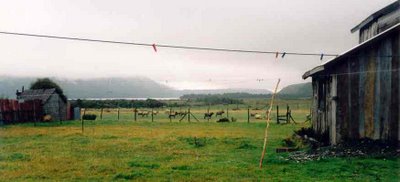Thursday, October 19, 2006

Darwin’s road to Cu-cow, 1835
On January 24, Darwin and his companions left Castro with fresh horses. “At Chonchi we struck across the island, following intricate winding paths, sometimes passing through magnificent forests, and sometimes through pretty cleared spots, abounding with corn and potato crops.” He found this a pleasing landscape, since it reminded him of the wilder parts of England… When he came to Huillinco, and Lago Cucao, the landscape changed again. “…. Only a few fields were cleared; and all the inhabitants appeared to be Indians. This lake is twelve miles long, and runs in an east and west direction.”
Like Chatwin 140 years later he travelled over the lake: “The road to Cucao was so very bad that we determined to embark in a periagua…a strange rough boat, but the crew were still stranger: I doubt if six uglier little men ever got into a boat together.”
He did not however (like Chatwin) travel with a corpse, but still with a strange passenger. “In the same periagua with us, a cow was embarked. To get so large an animal into a small boat appears at first a difficulty, but the Indians managed it in a minute. They brought the cow alongside the boat, which was heeled towards her; then placing two oars under her belly, with their ends resting on the gunwale, by the aid of these levers they fairly tumbled the poor beast, heels overhead, into the bottom of the boat, and then lashed her down with ropes. At Cucao we found an uninhabited hovel (which is the residence of the padre when he pays this Capella a visit), where, lighting a fire, we cooked our supper, and were very comfortable.”
The modern travellers came by bus, although the road was still quite bad. We stayed at the relatively comfortable and cosy Posada Cucao, probably the best hostel in the village. The back yard, with Lago Cucao behind, is seen in the picture. The chickens are seen first feeding in the front yard, then at dinner they appear on the table. The room was however feeling damp all the time and had a mouldy smell, reminding us that Chiloë is wet and rainy all year around.